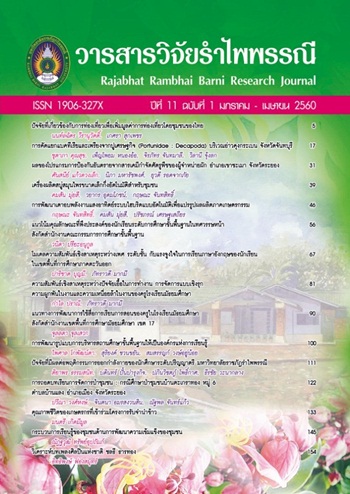โมเดลความสัมพันธ์เชิงสาเหตุระหว่างเพศ ระดับชั้น กับแรงจูงใจในการเรียนภาษาอังกฤษของนักเรียนในเขตพื้นที่การศึกษาภาคตะวันออก
Main Article Content
บทคัดย่อ
การวิจัยนี้มีวัตถุประสงค์เพื่อพัฒนาโมเดลความสัมพันธ์เชิงสาเหตุระหว่างเพศ ระดับชั้น กับแรงจูงใจในการเรียนภาษาอังกฤษของนักเรียนในเขตพื้นที่การศึกษาภาคตะวันออก และตรวจสอบความสอดคล้องของโมเดลกับข้อมูลเชิงประจักษ์ กลุ่มตัวอย่างเป็นนักเรียนชั้นประถมศึกษาปีที่ 6 และชั้นมัธยมศึกษาปีที่ 3 ของโรงเรียนในเขตพื้นที่การศึกษาภาคตะวันออก ปีการศึกษา 2558 จำนวน 500 คน ซึ่งได้มาจากการสุ่มแบบหลายขั้นตอน เครื่องมือที่ใช้ในการวิจัย คือ มาตรวัดแรงจูงใจในการเรียนภาษาอังกฤษของนักเรียนในเขตพื้นที่การศึกษาภาคตะวันออก วิเคราะห์ค่าสถิติพื้นฐานโดยใช้โปรแกรม SPSS และวิเคราะห์โมเดลความสัมพันธ์เชิงสาเหตุโดยใช้โปรแกรม Mplus 7.31
ผลการวิจัยปรากฏว่า
- โมเดลความสัมพันธ์เชิงสาเหตุระหว่างเพศ ระดับชั้น กับแรงจูงใจในการเรียนภาษาอังกฤษของนักเรียนในเขตพื้นที่การศึกษาภาคตะวันออกที่พัฒนาขึ้น แสดงให้เห็นว่า เพศและระดับชั้นมีอิทธิพลทางตรงต่อแรงจูงใจในการเรียนภาษาอังกฤษของนักเรียน โดยที่เพศหญิงมีแรงจูงใจในการเรียนภาษาอังกฤษดีกว่าเพศชาย และนักเรียนในระดับชั้นประถมศึกษาปีที่ 6 มีแรงจูงใจในการเรียนภาษาอังกฤษดีกว่านักเรียนในระดับชั้นมัธยมศึกษาปีที่ 3
- โมเดลที่พัฒนาขึ้นมีความสอดคล้องกับข้อมูลเชิงประจักษ์อยู่ในเกณฑ์ดี (ค่าสถิติ ไค-สแควร์ เท่ากับ 49.40 ค่า df เท่ากับ 36 ค่า p เท่ากับ .07 ดัชนี TLI เท่ากับ .99 ดัชนี CFI เท่ากับ .99 ค่า SRMR เท่ากับ .03 และค่า RMSEA เท่ากับ .03) ตัวแปรทั้งหมดในโมเดลสามารถอธิบายความแปรปรวนของตัวแปรแรงจูงใจในการเรียนภาษาอังกฤษของนักเรียนในเขตพื้นที่การศึกษาภาคตะวันออกได้ร้อยละ 15.2
สรุปได้ว่า เพศหญิงมีแรงจูงใจในการเรียนภาษาอังกฤษดีกว่าเพศชาย และนักเรียนในระดับชั้นประถมศึกษามีแรงจูงใจในการเรียนภาษาอังกฤษดีกว่านักเรียนในระดับชั้นมัธยมศึกษา
Article Details
เอกสารอ้างอิง
2. ภัทราวดี มากมี. (2559). การพัฒนาโมเดลการวัดประสิทธิผลองค์การภาครัฐในเขตอาเซียน: การวิเคราะห์โมเดลสมกาโครงสร้างพหุระดับ. วารสารสมาคมนักวิจัย. 21 (มกราคม-เมษายน): 34-38.
3. วิสุทธิ์ กล้าหาญ และสุชาดา กรเพชรปาณี. (2554). ความสัมพั นธ์เชิงสาเหตุของความสามารถในการปรับตัวทางการเรียนของนักเรียนชั้นมัธยมศึกษาตอนต้นในโครงการภาคภาษาอังกฤษ. วารสารวิทยาการวิจัยและวิทยาการปัญญา. 7 (เมษายน-กันยายน): 86-97.
4. วีระพงษ์ ปัญญาธนคุณ. (2553). ประชาคมอาเซียนกับแนวโน้มด้านภาษาในภูมิภาคเอเชียตะวันออกเฉียงใต้. วารสารอาเซียนศึกษา มหาวิทยาลัยวลัยลักษณ์. 1 (กันยายน-ตุลาคม). สถาบันทดสอบทางการศึกษาแห่งชาติ (องค์การมหาชน). ผลการทดสอบทางการศึกษา O-NET. [online]. เข้าถึงได้จาก:http://www.niets.or.th/th. 2557
5. Pheary Tan, สมพร สุทัศนีย์ และสุพิมพ์ ศรีพันธ์วรสกุล. (2558). การพัฒนามาตรวัดแรงจูงใจการเรียนภาษาอังกฤษสำหรับนักเรียนชั้นมัธยมศึกษาตอนปลายในราชอาณาจักรกัมพูชา. วารสารวิทยาการวิจัยและวิทยาการปัญญา. 11 (ตุลาคม-มีนาคม): 16-27.
6. Anderman, E. M., Maehr, M. L., & Midgley, C. (1999). Declining motivation after the transition to middle school: Schools can make a difference. Journal of Research & Development in Education. 32 (May): 131–147.
7. Bai, H., Wang, L., Pan, W., & Frey, M. (2009). Measuring mathematics anxiety: Psychometric analysis of a bidimensional affective scale. Journal of Instructional Psychology. 36 (September): 185-194.
8. Bandura, A. (1997). Self-efficacy: The exercise of control. New York: Henry Holt And Company.
9. Berglas, S., & Jones, E. E. (1978). Drug choice as a self-handicapping strategy in response to noncontingent success. Journal of Personality and Social Psychology. 36 (April): 405–417.
10. Bouffard, T., Marcoux, M. F., Vezeau, C., & Bordeleau, L. (2003). Changes in self‐perceptions of competence and intrinsic motivation among elementary schoolchildren. British Journal of Educational Psychology. 73 (June): 171-186.
11. Bouffard, T., Vezeau, C., & Bordeleau, L. (1998). A developmental study of the relation between combined learning and performance goals and students' self‐regulated learning. British Journal of Educational Psychology. 68 (September): 309-319
12. Carreira, J. M. (2006). Motivation for learning English as a foreign language in Japanese elementary schools. JALT JOURNAL. 28 (November): 135.
13. Castle, C. S. 1913. A statistical study of eminent women. No. 27. Washington: Science Press.
14. Covington, M. V. 1992. Making the grade: A self-worth perspective on motivation and school reform. Cambridge: Cambridge University Press.
15. Gegenfurtner, A., & Vauras, M. (2012). Age-related differences in the relation between motivation to learn and transfer of training in adult continuing education. Contemporary Educational Psychology. 37 (January): 33-46.
16. Ghenghesh, P. (2010). The motivation of L2 learners: Does it decrease with age?. English Language
Teaching. 3 (Mar): 128.
17. Gresham, G. (2008). Mathematics anxiety and mathematics teacher efficacy in elementary pre-service teachers. Teaching Education. 19 (July): 171–184.
18. Hong-Nam, K., & Leavell, A. G. (2006). Language learning strategy use of ESL students in an intensive English learning context. System. 34 (September): 399-415.
19. Hooper, D., Coughlan, J., & Mullen, M. (2008). Structural equation modelling: Guidelines for determining model fit. Articles. 2 (January: 58.
20. Kurita, J. A., & Zarbatany, L. (1991). Teachers’ acceptance of strategies for increasing students’ achievement motivation. Contemporary Educational Psychology. 16 (July): 241–253.
21.Kormos, J., & Csizér, K. (2008). Age‐related differences in the motivation of learning English as a foreign language: Attitudes, selves, and motivated learning behavior. Language Learning. 58 (June): 327-355.
22. Lau, K. L. (2009). Grade differences in reading motivation among Hong Kong primary and secondary students. British Journal of Educational Psychology. 79 (December): 713-733.
23. Lau, S., & Roeser, R. W. (2002). Cognitive abilities and motivational processes in high school students’ situational engagement and achievement in science. Educational Assessment. 8 (June): 139–162.
24. Lau, Shun, Liem, A. D., & Nie, Y. (2008). Task- and self-related pathways to deep learning: The mediating role of achievement goals, classroom attentiveness, and group participation. British Journal of Educational Psychology. 78 (December): 639–662.
25. Maccoby, E. E., & Jacklin, C. N. (1974). The psychology of sex differences. Vol. 1. Stanford: Stanford University Press.
26. Marsh, H. W., Craven, R., & Debus, R. (1999). Separation of competency and affect components of multiple dimensions of academic self-concept: A developmental perspective. Merrill-Palmer Quarterly: Journal of Developmental Psychology. 45 (October): 567-601.
27. Martin, A. J. (2009). Motivation and Engagement Across the Academic Life Span A Developmental Construct Validity Study of Elementary School, High School, and University/College Students. Educational and Psychological Measurement. 69 (October): 794–824.
28. Meece, J. L., Glienke, B. B., & Burg, S. (2006). Gender and motivation. Journal of school Psychology. 44 (October): 351-373.
29. Midgley, C., Maehr, M. L., Hruda, L. Z., Anderman, E., Anderman, L., Freeman, K. E., & Urdan, T. (2000). Manual for the patterns of adaptive learning scales. Ann Arbor. 1001: 48109-1259.
30. Mori, S., & Gobel, P. (2006). Motivation and gender in the Japanese EFL classroom. System. 34 (June):194-210.
31. Muhammad, A., & Mamuna, G. (2013). Gender and Language Learning Motivation. Academic Research International. 4 (March): 266-423
32. Parker, J. C. (2007). Gender differences in the motivation to learn. Doctoral dissertation, The Evergreen State College.
33. Pintrich, P. R., & Schunk, D. H. (2002). Motivation in education: Theory. Research, and Applications, Second Edition, Merrill Prentice Hall, Columbus, Ohio. New Jersey: Merrill Prentice Hall.
34. Robins, R. W., & Pals, J. L. (2002). Implicit self-theories in the academic domain: Implications for goal orientation, attributions, affect, and self-esteem change. Self and Identity. 1 (September): 313–336.
35. Schunk, D. H., Pintrich, P. R., & Meece, J. L. (2008). Motivation in education: Theory, research, and applications. New Jersey: Pearson/Merrill Prentice Hall.


